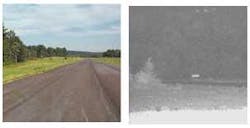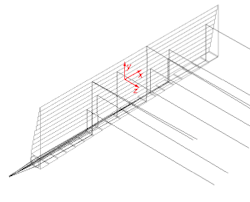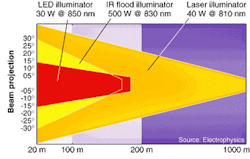Increased demand for 24-hour surveillance of public, government, and military areas such as borders, airports, bridges, industrial facilities, ports, military bases, reservoirs, and large public facilities like sports stadiums is placing ever-increasing demands on security-systems professionals. Concerns about leveraging installed camera systems, the impact of light pollution on neighboring areas, and long-term service issues need to be met with reliable solutions that make economic sense. A new class of high-power, eye-safe infrared (IR) laser illuminators is now available that extends the use of low-cost visible cameras into nighttime and low-light operation under a wide range of lighting conditions.
Though active-IR illumination systems have been fielded for several years, limitations existed. Infrared illuminators based on light-emitting-diode (LED) bundles are limited to short-range applications. Infrared-filtered incandescent systems suffer from low efficiency and short service life.
Technology Integration Group (Carlisle, MA) and Ford Motor Company (Dearborn, MI) developed an IR laser illuminator for automotive night vision using an 808-nm-emitting laser diode integrated with a thin-sheet optic and holographic diffuser. The Office of Naval Research (Arlington, MA) and Qualume (Alton, NH) carried out development of IR illuminators for nonautomotive applications in 2002. These developments led to illuminators now being commercially produced by Electrophysics that contain a sealed laser diode and potted electronics for outdoor use and operate at power levels of 5, 20, or 40 W. Advances in optics resulted in a reduction in size; for example, a 40-W version with beam patterns between 10° and 80° has a light-source aperture of less than 80 sq in.
Although laser illuminators have previously been used, their applications have been limited in power levels and/or wavelengths because of hazards to the eyes of users and bystanders. The concepts developed for automotive applications overcome this problem by expanding the laser beam to the point at which its power density no longer is in the hazard regime. The beam expansion is carried out by a class of optics called sheet optics, which can be implemented in various ways.1, 2 Concepts based on refraction, reflection, diffraction, and geodesic optical elements have been developed.
Generally, several types of optical elements are used in a system, often combined in a single monolithic part (see Fig. 1). They all are quite compact and efficient with beam expansions of four to five orders of magnitude in optical elements a few millimeters thick and with efficiencies in excess of 60%. In fact, one of the principal advantages of laser-based illuminators is their high optical efficiency. The laser light beam is expanded in a sheet optic about 6 in. wide. The expanded beam passes through a holographic screen that spreads the beam to the desired angular distribution.Eye-safety considerations
Eye safety of laser devices is determined by comparing the radiation intensity with maximum permissible exposure (MPE) levels. These MPE values are a function of exposure duration, wavelength, and other factors. The limits are determined by extensive testing under the supervision of a number of national and international agencies.
The output of a near-IR sheet-optic laser illuminator has been compared to the applicable MPE by a Ford team.3 Using the same methods, the outputs of the Electrophysics illuminators were compared to the MPE and found to be about an order of magnitude below the danger level under the worst conditions (constant staring at about 8 in. from the output surface). This means that they can be classified as Class 1 laser devices that can be used with no restrictions on mounting and handling.
Performance benefits
The high output power of the laser illuminator makes it possible to effectively image at ranges in excess of 1000 m. Specific range performance is determined by a number of factors including the path length, the power of the illuminator, the field of emission of the illuminator beam, the transmissivity of the atmosphere, the IR sensitivity of the camera, the f-number of the lens, and the effective reflectivity of the illuminated object.
As described by the inverse-square law, as the luminous flux travels away from the light source, the power of the beam decreases by the square of the distance. The reflected energy is also subject to the same effect, leading to a reduction in effectiveness that decreases roughly as the fourth power of distance. Imaging at such long distances is thus a significant achievement. In comparison, LED-based illuminators typically provide a maximum range of 100 m (see Fig. 2).Camera and lens selection are important when considering the use of IR illuminators. Today's color cameras are designed to precisely capture irradiance in the visible spectrum between 380 and 760 nm using filters, which limits the cameras' sensitivity to IR light. Security cameras are typically monochromatic since they provide increased resolution, significantly higher low-light sensitivity (typically below 0.001 lux), and spectral response out to 1000 nm. Electrophysics has conducted most of its testing with a charge-coupled-device (CCD) camera with a variety of f1.4 lenses with different focal lengths and an IR 10-nm-bandpass filter centered at 810 nm. The use of the filter minimizes the influence of light sources in the field of view on the camera gain setting while still providing adequate daylight sensitivity.
Turning night into day
There are a significant number of advantages to using IR illuminators in security monitoring systems. The ability to see in total darkness is obvious; however, video security scenarios typically include light sources, which potentially impact the effectiveness of closed-circuit-camera performance. Illuminators provide even light throughout the beam pattern, eliminating shadows or areas adjacent to bright light sources where someone might go undetected within the blooming artifact of the camera. Most camera systems use some type of automatic gain control (AGC), which may not provide optimal image quality under lighting conditions typically found in areas monitored by camera systems. Any location where lighting levels are uneven—such as under the decks of bridges, parking lots, or tunnels—can be effectively illuminated 24 hours a day using laser illumination (see photo at top of this page).
Illuminators operating at 810 nm emit a slight red glow that may be seen under conditions of total darkness and in which the illuminator's diffuser is directly visible. Using an indirect lighting setup will eliminate any observable light signature. For applications requiring totally covert operation, longer-wavelength laser illuminators can be used. Although the laser-illuminator optics will work with lasers over a wide spectrum, the quantum efficiency of CCD cameras falls off significantly as the wavelength approaches 1000 nm. For example, the range performance of a 900-nm laser illuminator/CCD camera setup is reduced to approximately 75% to 80% of the illumination range of an 800-nm system when the scene is in total darkness. In cases in which the illuminator is being used to optimize the illumination of a scene where other light is present, however, there is no reduction in performance because the camera's response to the ambient light is reduced by the same factor. For most public area surveillance monitoring, the need for covert operation is not required.
Although the unit cost of laser-based illuminators is higher than LED illuminators, their use in appropriate situations can bring significant cost savings. Because of their high efficiency (four to fives times that of LEDs and greater than 20 times that of incandescent illuminators), laser-based systems can put out far more power per unit cost than other systems. For example, a single 40-W illuminator can light up an area of more than 15 acres with excellent image quality using a monochromatic CCD camera with good IR sensitivity. It would require multiple conventional illuminators with individual mounting structures and increased maintenance costs to accomplish the same effect. When portable or remote installations are being considered, the higher efficiencies translate into dramatic reductions in the size and cost of the power sources, whether battery, solar, or other.
Laser illumination vs. thermal imaging
With the introduction of lower-cost thermal cameras, an increasing number of applications may potentially change over to the use of thermal cameras. There are many advantages to thermal imaging for security monitoring and defense-surveillance-related applications. Thermal imaging is totally passive, provides very high contrast (under most environmental conditions), and is effective in detecting intruder movement, even at the limits of the camera's range. However, for the vast security marketplace, installing illuminators is likely more cost-effective and extends existing camera infrastructure and will even improve daytime camera performance under difficult lighting conditions. In addition, visible/near-IR CCD cameras provide higher resolution and mate up with a wide range of low-cost zoom lenses that can capture details such as license-plate numbers, ship and plane registration markings, and identifiable images of people for potential use in criminal prosecutions at ranges from a few meters to 1000 m.
ACKNOWLEDGMENT
The author thanks Tim Fohl, technical director for Qualume (Alton, NH), for his assistance in preparing this article.
REFERENCES
- M. A. Marinelli and J. T. Remillard, Proc. SPIE 3285 and 170 (1998).
- J. T. Remillard et al., Diff. Optics and Micro-Optics, 10, OSA Tech. Digest Series, 192 (1998).
- J. T. Remillard, W. H. Weber, and T. Fohl, Proc. SPIE 4285, 14 (2001).
About the Author
Arthur Stout
Arthur Stout is the director of AI Product Management for Teledyne FLIR’s OEM Infrared Camera division in Santa Barbara, CA. He is a 30-year veteran in business development, marketing, and product management in the IR imaging industry.


